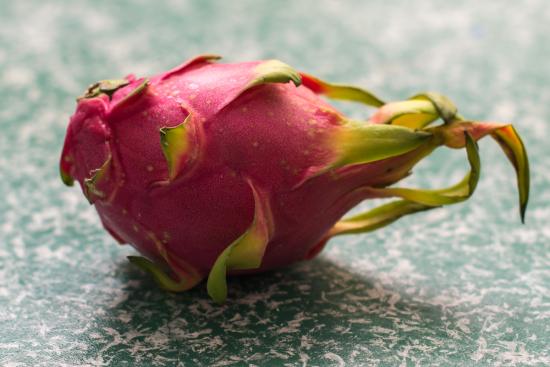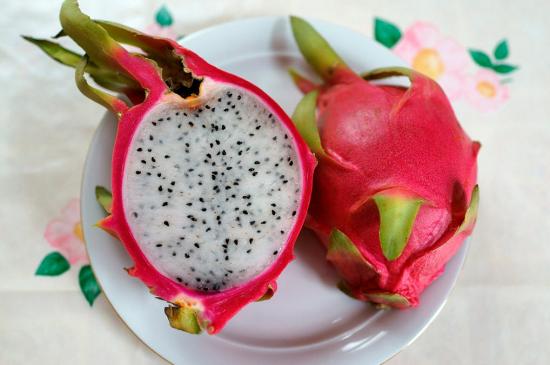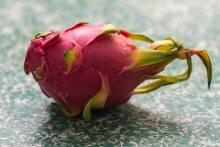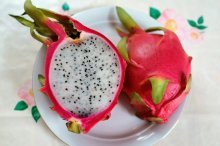How to grow dragon heart fruit at home

Dragon's Heart is a fruit, a very unusual, exotic fruit of a liana-like, epiphytic cactus. This fruit has many names: pitaya, pitahaya, prickly pear, dragon fruit, dragon heart and a number of other names, depending on where the cactus grows.
This plant is cultivated in the countries of Southeast Asia, such as: Philippines, Thailand, Malaysia, Indonesia, Sri Lanka, Japan, China, Israel. And also in Central and South America and northern Australia. But this is the birthplace of the prickly pears Mexico is considered.
Content:
- Legend of the Dragon's Heart
- Reproduction methods, soil preferences, planting
- Requirements for watering, lighting, temperature
- Growing and care
Legend of the Dragon's Heart
The ancient Aztecs had an unusual legend about the heart of a dragon. And, as everyone knows, the Aztec civilization was located on the territory of modern Mexico, and was famous for its mythology. This legend told about many years of brutal war between people and dragons that spewed fire.
Time after time, battle after battle, the huge dragons lost the battle to the brave Indian warriors.
When the mighty beasts could no longer spit out flames, they, exhausted, spat out their hearts from their mouths and died.According to legend, the Indians won a brutal war and exterminated the mighty dragons. In memory of that great victory, an unusual plant appeared in the lands of the Aztecs, the fruit of which, like two peas in a pod, looked like a red and prickly dragon heart.
Appearance, beneficial properties, composition, different types of pitaya
The pitahaya plant is a vine-like, climbing, epiphytic cactus with a three-lobed stem. Reaches a height of 10 meters. Depending on the type cactus, its fruits also differ:
- by the color of the flesh, which can be bright red, yellow or white
- by size (from 150 to 800 g)
- by skin color (from yellow to bright red)

The most common types of this plant are Costa Rican pitahaya, yellow pitahaya and red pitahaya. Ripe “dragon heart” contains a number of useful substances:
- phosphorus
- protein
- vitamins C and B
- riboflavin
- iron
- niacin
- calcium
- theanine
Pitaya has beneficial properties, which have a beneficial effect on the human body:
- normalization of intestinal function
- tonic effect on the cardiovascular system
- Eliminates bloating and indigestion
- strengthening vision
- healing of wounds and cuts
- memory improvement
- weight loss
Juice from cactus stems has an anthelmintic effect, but it must be consumed with caution to avoid overdose. Pitaya can cause an allergic reaction, like any tropical fruit, so precautions must be taken when consuming this fruit.
Reproduction methods, soil preferences, planting
Pitaya blooms and bears fruit all year round, if there are suitable conditions for this. In Thailand, for example, up to seven harvests are harvested from these plants per season.Unlike desert cacti, pitahaya does not tolerate heat and prefers a humid subtropical climate. The plant feels good at temperatures from +25 to 30°C, withstands heat up to + 40°C and cold down to 0°C.
Propagated by cuttings, seeds, and also by grafting. The seeds are sown to a depth of no more than one centimeter, the soil is moistened and covered with transparent glass or film to achieve a greenhouse effect. After germination seedlings are seated.
On industrial plantations, pitahaya is grown on strong supports, which over time are covered by a network of aerial sucked roots, and a cactus on a support looks like a large green fountain. The plant is not demanding on soil quality. The main thing is that the soil is well-drained, since if it becomes waterlogged, the pitahaya dies.
Seedlings are planted in the ground in the spring, level with the soil, the bottom layer of which is mixed with a small amount of slow-acting fertilizer to accelerate plant growth. At home, pitahaya grows well both in pots and in greenhouses. When planting in pots, sandy soil is used with the addition of substrate and compost. The bottom of the pot should have drainage holes and a layer of small stones.
Requirements for watering, lighting, temperature
Almost immediately this plant needs to be provided with support, since it is an epiphyte. When watering the plant, try to moisten only two-thirds of the root. The bottom layer of soil should remain dry. The support also needs to be moistened. Watering is carried out when the soil dries to a depth of two centimeters approximately once a week.

Pitahaya is demanding of sunlight: the plant must be illuminated 80% of the day.If the "dragon heart" is grown at home, then the cactus must be illuminated using a special lamp for indoor flowers. In winter, the plant practically stops being watered, the temperature around it can be lowered from 27 to 17°C, and the lighting intensity can be reduced.
Growing and care
During the period of formation and growth, the plant needs to be fed, but not overdo it, since pitahaya dies from overeating. You can feed them once every two months with low-nitrogen and slow-release fertilizers.
If growing conditions are optimal, pitahaya develops very quickly. To avoid excessive weight and redirect nutrients, the plant must be pruned. “Dragon Heart” tolerates pruning easily. With sufficient light, nutrition and temperature, pitahaya forms buds over several weeks and blooms.
Flowering occurs in the dark and only one night. In nature, flowers are pollinated by bats and insects, but at home, cross-pollination with a brush or cotton pad is necessary, although this may not be necessary, because many species are considered self-pollinating. If pollination is successful, the flower withers and its base begins to swell.
Fruit ripening occurs from July to December. Dragon's heart is an unpretentious plant, and its cultivation is a fascinating and rewarding activity, since this exotic fruit, along with a wonderful taste, also has mass useful properties.
Video about the beautiful tropical fruit pitahaya:










